A whole pork shoulder separates into butt roast and picnic roast portions; leaving most of the blade bone in the butt portion and most of the front leg bones in the picnic. Due to only containing the blade bone, pork shoulder butts lend themselves well to both retail cut fabrication and cooking whole. Because butts contain less bone than picnics and require less labor to debone, they are also a favorite for small-scale sausage production. Picnics are less in demand/cost less per pound and are primarily used in commercial sausage making. In the area abutting the butt separation of picnics there’s a about a 2 1/2 pound piece of clean, lean muscle that is often separated and sold as “cushion meat.” The muscle group that makes up the picnic cushion actually extends up past the butt – picnic separation, but is bisected during sub-primal cut fabrication. Commercially and in restaurants, cushion meat is desirable to lean-up sausage formulations or to further process into shredded pork products. As with the majority of retail fresh pork, vacuum packaged cushion meat has been pumped with at least salt-water. Salt and water are considered to be natural ingredients; so the only indication on the label of “Natural” fresh pork is a required “minimally processed” statement. It’s important to remember to cut back on added salt amounts unless you are certain of not having bought harvest plant pumped pork.
Our local Gordon’s Food Service outlet carries vacuum packaged bags of cushion meat, plus GFS does not charge a membership fee for shopping there. There are 4 pieces of cushion meat per bag; so they are sold in packages averaging around 10 pounds. Presumably due to the supply & demand, Gordon’s sells this lean boneless cushion meat for a dime less per pound than they charge for bone-in and much fatter whole butts.
Size matters, I get that. At an average weight of 2 1/2 pounds, individual cushions don’t make appealing roasts for smoke-cooking. Hand stuffing cushion meat chunks into 10 pound capacity semi-permeable fibrous casings remediates that problem. For several years now I have heard feedback that knife boning butts for stuffing is not appealing because blade bones can be easily and cleanly removed upon the completion of smoke-cooking. I accept that reasoning; even though casings save a lot of money on spice rub & foil costs, they help hold just enough moisture around cooking meat for it to gel more rapidly, provides a uniform cooking dimension, bones and fat seams are not present to cause uneven cooking, increased exterior meat surface area provides for more chewy & smoky protein skin in finished product, uniform casing size tends to maximize a smoke-cooking units capacity, casings prevent over-smoking/finished product surface char and a homemade $250 smoke-cooking unit does an excellent job when used in conjunction with a conventional home oven. For the record, removing blade bones from raw butts with a knife provides an opportunity to feel for and remove bone-fragments that are often generated when whole pork shoulders are basically thrown through saws on moving (conveyors) pork cut fabrication lines.
FOLLOW THESE STEPS TO EASILY AND INEXPENSIVELY MAKE GREAT SMOKED PULLED-PORK.
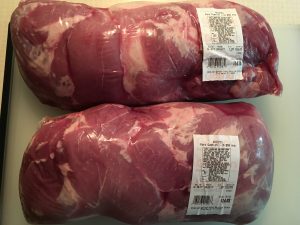
Boneless, lean pork picnic cushion meat from a, no membership needed, Gordon’s Food Service (GFS) store. Each vacuum bag weighs around 10 pounds and contains 4 pieces of cushion. Cut each whole cushion into 6 nearly equal size chunks. Resulting chunks of pork shoulder meat are large enough to make nice size shreds and are still small enough so that marinate readily absorbs into all meat. No fat trimming was performed.
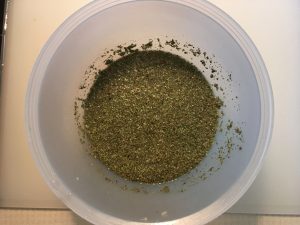
Marinates are preferred over spice rubs because exterior rubs do not react with all the meat, rubs are much more expensive and rubs largely drip away along with cooking purge. This marinate for 20 pounds of starting raw cushion meat contained the following: 4 tsp. food-grade roast sodium phosphate, 2/3 cup of water, 2 2/3 cups of beer, 2 1/3 TBSP purified salt (some salt-water is already in most fresh pork), 9 gloves of crushed garlic. 4 TBSP leaf marjoram and 1 1/2 TBSP coarse ground black pepper. It’s basically fresh Polish sausage seasoning with beer added and the aroma is off the charts good.
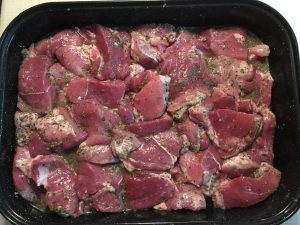
Here, approximately 20 pounds of cushion is mixed with the marinate in a large rectangular oven roasting pan. Cover the pan with its lid then place under refrigeration. Overhaul (turn) meat chunks twice during an approximately 36 hour marination period. I use a long handled wooden spoon to turn the marinating meat chunks.
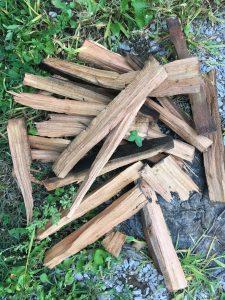
Get ready for smoking by splitting up a short hardwood log. This wood is cherry, but most hardwood will work well; as long as it’s not too pungent (black locust immediately comes to mind as being too pungent).
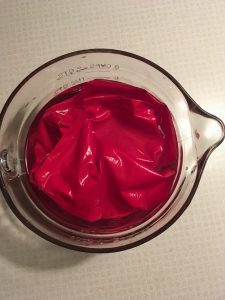
Two 10 pound capacity semi-permeable fibrous casings soaking in warm water. Soak for about 1/2 hour prior to stuffing them with meat. There’s no need to add vinegar etc. to prevent casing from sticking to finished product; because casings are stripped prior to cooking completion.
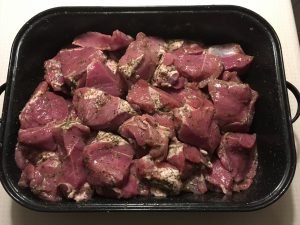
Within 36 hours, plant pumped fresh pork will soak up about as much marinate as it’s going to. Use your fist of tightly stuff cushion chunks into casings. Cotton butcher’s twine can be used to tie casings closed. I had two chunks of cushion leftover after the casings were full, so I put them in a foil formed cup and sat them between the chubs on the top smoker rack.
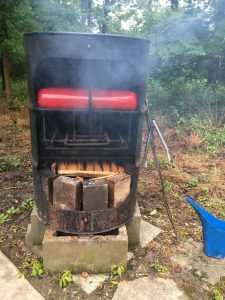
Two charcoal chimney starter loads of briquettes were barely lit than split hard wood was placed on top of it. The water pan was filled and everything stood ready for putting the cooker’s shroud in place. Since there were only 2 chubs (this smoke-cooker has a 6 chub capacity), I only went 6 hours in the smoke-cooker. During that time I topped-off the water pan twice and added 2/3 charcoal chimney of partially lit briquettes once. The smoke-cooker was not opened during the 6 hours, water went down a copper refill tube and charcoal was dropped down the 3 inch diameter flue/fuel pipe. When the cast iron water becomes full and starts to overflow, ash comes out the flue/fuel pipe signaling to stop adding water. Dropped charcoal is flicked onto the forward sloping fire grate. The Wolfer smoke-cooker has very low labor requirements; if I can hold my hand on top of the drum for 3 seconds it’s time to add more partially lit charcoal. If the sun is shining intensely on the black drum top I feel for heat level near the top of a shaded side of that thermal processing unit. Charcoal supplies heat and keeps hardwood smoldering. The by design low – steady airflow of this cooker keeps heat in the 220- 250F range. Further, firebricks and the water pan even out heat highs and lows.

$250 (new materials & supply costs), durable smoke-cooker with shroud in place.
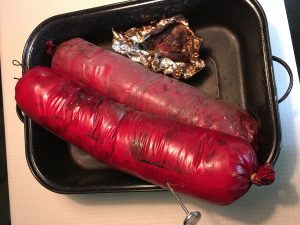
Pork chubs after 6 hours in the smoke-cooker. Internal temperature was 155F. Casing exteriors were rinsed off the a sink prior to stripping.
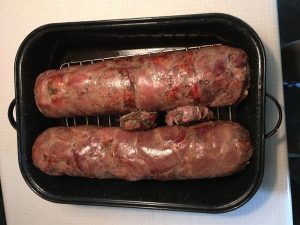
Smoking phase completed and heading covered into a 220F oven. Meat is sitting on a cooking rack to keep it up out of cooking purge. Light steam in the closed roaster aids in gelling collagen.
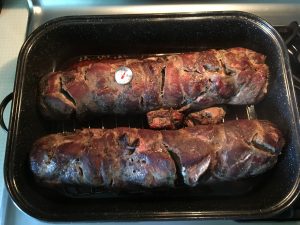
Pork hit the target temperature of 195F internal after 3 1/2 hours in the oven; that’s 9 1/2 hours total thermal processing time. If you want the pork to be even easier to pull, cook it to 200F internal. But, the higher it goes in temperature, the more the end-product tends to dry out.
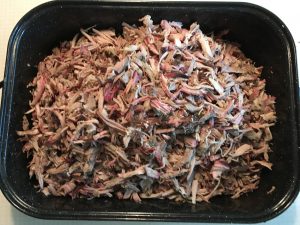
Pulling was the most labor intensive phase using this technique, and it didn’t take all that long.
End-product was excellent; with the exception of possibly being little dryer than similarly processed pork shoulder butts. Oh well, I guess that’s why barbecue sauce was invented. Be a money & time wasting pit master, or just cook like one.
